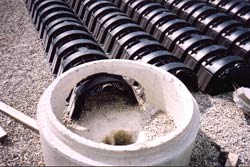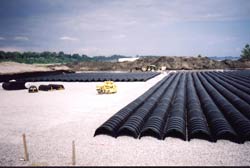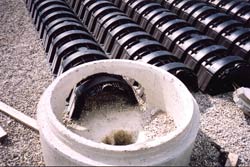
Case Study: In Municipal Chambers
Protecting environmental and public health in wastewater treatment plants
 Population and regulatory demands, an increased awareness of the need to protect sensitive areas, and the value of water as a resource are driving new ways of thinking about how decentralized wastewater treatment can be used to manage these issues.
Population and regulatory demands, an increased awareness of the need to protect sensitive areas, and the value of water as a resource are driving new ways of thinking about how decentralized wastewater treatment can be used to manage these issues.
Part of the development in thinking is a move toward the use of advanced wastewater treatment and onsite disposal technology in municipal applications. Infiltration chambers have played a large role in the ever-expanding number of applications for decentralized treatment.
One example of a municipal application is in extending the life of wastewater treatment facilities and providing effective treatment in community-wide systems. With government funding for these projects hard to come by, some municipal managers are accommodating growth by enhancing current facilities or coordinating wastewater treatment programs and needs regionally and even by community. Wastewater treatment is at the center of this issue because the cost for sewer extensions and centralized treatment plant expansions is high and not a favored expenditure by most taxpayers.
In most communities, sustaining development and growth while protecting the natural environment is the mandate. Watersheds and groundwater supplies are critical areas under close scrutiny when in the proximity of any potential runoff or pollutant stream. Even municipalities need to closely regulate the capacity and quality of their infrastructure systems and how expansions or changes will affect the surrounding area.
Port Burwell
A case in point: The Port Burwell Sewage Treatment Plant sits on the shore of Big Otter Creek near Lake Erie in Bayham, Ontario. To accommodate growth, the community decided to connect the surrounding communities to the plant and explore how this facility could be modified for future efficiency, added capacity, and environmental stability.
Engineers evaluated the expansion options for the facility and created a conceptual design report based on projected population growth in and around the Big Otter Creek area. The report determined that the treatment capacity of the existing plant would have to be expanded from 528 cubic meters per day (m3/d) to 1,060 m3/d.
After an extensive investigation of three options, the engineers recommended an onsite solution that would convert the outfall to an exfiltration bed using Infiltrator® chambers. The exfiltration chamber system provided additional pollutant removal.
The chamber gallery is located in the plant outfall easement next to the treatment facility and provides sufficient capacity to discharge the effluent from the sequencing batch reactors (SBRs) on a sequential basis, including a 25 percent surcharge. The design also includes ports and manholes to enable bed inspection. The entire bed area is excavated to a depth of 1.2 meters.
 Engineers were concerned from the start that fluctuating groundwater levels could result in a submerged bed, so they designed the hydraulics to bring plant effluent into the bed and filter through the soil and then the groundwater. After the operation began, engineers made adjustments to the system for the groundwater issue.
Engineers were concerned from the start that fluctuating groundwater levels could result in a submerged bed, so they designed the hydraulics to bring plant effluent into the bed and filter through the soil and then the groundwater. After the operation began, engineers made adjustments to the system for the groundwater issue.
As of April of 2008, the exfiltration system has more than met the original capacity projections and environmental requirements and has performed trouble-free, according to Ed Roloson, manager of the Port Burwell facility. Fluctuating groundwater levels continue to challenge the project but have been managed through the addition of some tiling to control the flow to the exfiltration galleries. In addition, vegetation has grown above the system as planned so that it is nearly invisible to the eye and does not obscure the landscape.
Vineyard Haven
Municipalities often are charged with finding a way to promote business in their area, while recognizing that existing outdated systems are underperforming and may even be a threat to public health. This was the case at Vineyard Haven, one of several small towns on Martha’s Vineyard in Massachusetts. A prominent summer vacation spot, the downtown has numerous buildings used for retail and a whole host of services for the year-round and escalating summer populations. These buildings have been on individual septic systems for years and, until several years ago, many were still operating substandard cesspools as their onsite wastewater treatment system. A percentage of the buildings in the downtown area were experiencing ongoing problems with their individual on-site sewage disposal systems, many of which did not meet Title 5 (Massachusetts Sanitary Code) standards.
Due to the close proximity of these buildings to Vineyard Harbor, the state was concerned that the inadequately treated wastewater would create a public health issue in this swimming and recreation area. As a result, the town was put under an Administrative Consent Order from the Massachusetts Department of Environmental Protection to halt the discharge of inadequately treated wastewater to the harbor. The community identified those systems in actual or imminent failure, and an engineering firm designed a system of low-pressure and gravity sewers to collect flow from only those buildings to correct the immediate and most critical problems.
Prior to making the final decision, the community evaluated several types of upgraded onsite wastewater treatment systems and cluster septic systems. In most cases, the individual properties did not have sufficient land area to install a replacement system or the groundwater levels in the immediate area were too high and would have compromised the treatment process.
The community decided that a centralized wastewater treatment facility with a groundwater discharge was the best solution. The system design, limited to the problematic buildings, included a collection system (gravity and low-pressure, small diameter pumps, and piping) and a 100,000-gallons-per-day (gpd) sequencing batch reactor. The engineers also designed two separate 50,000-gpd leaching fields. The engineers used Infiltrator® chambers because they are easy to install and offer layout flexibility. In addition, the chambers allowed the community to use the area above the system for recreational fields.
The SBR treatment facility pumps to both leachfields in the summer and alternates leachfields in the off season. The effluent is then pumped to the second leachfield about 1.5 miles from the treatment facility. The system also was designed to treat wastewater from septic trucks around the area as an added service. The facility and the disposal fields are performing as expected, resulting in no further issues with the wastewater from downtown businesses.
Looking ahead, the town is planning to solve nitrogen loading issues in two pond areas that could require an extension of the plant, including the need for an additional disposal field. A site for this additional field has been selected close to the original disposal fields. The Martha’s Vineyard Commission is studying the pond situation across the island and is expected to issue a report in the near future on needs and solutions.
About Infiltration Chambers
Chambers have been in use for over almost 40 years. They are an ideal solution for disposing water (wastewater, treated wastewater, stormwater, sump pump discharge…etc.) to the subsurface. The chamber has marked improvements over the historical stone trench. There can be reductions in installation time, material costs, and shipping costs, and the product is free of fines that can reduce permeability. Chambers provide an open interface, which increases surface area and enables increases in permeability and storage capacity.
About the Author
Dennis F. Hallahan, P.E., has more than 16 years of experience with on-site wastewater treatment systems design and construction and holds patients for onsite wastewater products. Currently technical director at Infiltrator Systems, Hallahan is responsible for government relations and technology transfer between the company and regulatory and design communities. He also oversees a staff that is responsible for product research and testing for both universities and private consultants. Hallahan received his master's degree in civil engineering from the University of Connecticut. To contact him, call 800-221-4436.